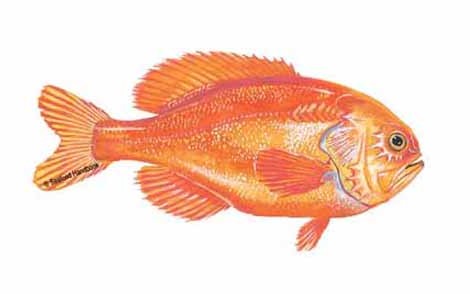Seafood Handbook Finfish Page
The Seafood Handbook is the most comprehensive seafood directory available online. Featuring more than 100 of the most common seafood species in the U.S. market, the Seafood Handbook is the ultimate guide to seafood sourcing and preparation, brought to you by the editors of SeaFood Business magazine. And it’s free!
For each type of seafood species, there is a comprehensive overview of the item, its origin, history, availability, product attributes, nutritional value and cooking tips, along with an original hand-drawn depiction.
Explore Finfish by searching here:
American eels are one of 15 related, snakelike fish species that include the European eel (Anguilla anguilla) and eels in tropical or subtropical rivers entering the Pacific or Indian oceans. Eels are catadromous, meaning that they spawn in the ocean but mature in fresh water. Most eels are caught… Read More
This high-valued species is the favored sea bream, prized in Mediterranean cuisine and highly regarded by European chefs. It gets the “gilt-head” name from the golden stripe between its eyes. The Romans reportedly called the bream “Aurata,” the gilded one. The Greek goddess Aphrodite also… Read More
This species was first fished commercially off New Zealand, and then later off of Australia. It was the New Zealanders who launched the marketing effort for the fish formerly known as slimehead — a distinct marketing handicap. After the Kiwis persuaded the Food and Drug Administration to allow… Read More
Historically, in Hawaii moi was a delicacy reserved for male royalty; commoners caught eating the fish faced severe punishment. Hence moi’s unofficial title as “the fish of kings.” While Westernization ended the prohibition on moi, access to the fish was limited due to depletion of the wild… Read More
The prized species that shares the dory name is the John Dory (Zeus faber), but only a small volume of this excellent and expensive fish is available in the United States. Two related species from New Zealand, black and smooth oreo dories, are more common to the U.S. market. Though they look a lot… Read More
Sablefish, thus known because of its black, almost furry skin, is also commonly called black cod, though it is not in the cod family. It is also called butterfish in reference to its melt-in-your-mouth, oil-rich meat. The oil makes sablefish an excellent species for smoking, a treatment relished by… Read More
Dozens of drum species are found in tropical waters of the Atlantic and Pacific oceans and in the Gulf Mexico. Of greatest value in a niche U.S. market are the red drum and black drum, named for the loud drumming noise they make by contracting muscles connected to their air bladders. Red drum is… Read More
Wahoo, a member of the Scombridae family of mackerels and tunas, is closely related to the king mackerel. Hawaiian lore has it that the name wahoo comes from European explorers’ misspelling of “Oahu” on early maps, since the fish was abundant around that island. The fish’s alternate name,… Read More
A premium whitefish, haddock is a member of the cod family, though smaller than Atlantic cod, generally weighing 2 to 5 pounds. The haddock bears a distinguishing black mark, often referred to as the “devil’s thumbprint” or “St. Peter’s mark,” in the “shoulder” area, and its skin is… Read More
One of the great success stories of modern aquaculture, Atlantic salmon farming first emerged on a commercial scale in the early 1980s, with Norway leading the way. Since that time, global production has increased tremendously, and Atlantic salmon are farmed in more than a dozen countries around… Read More















